10 Most Famous Egyptian Goddesses
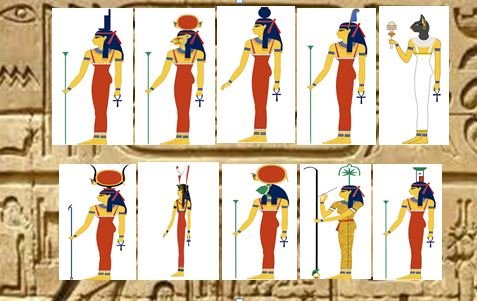
Egyptian goddesses
Ancient Egyptians had a plethora of deities that were often revered as the embodiment of a natural phenomenon or a human trait. Where as many of us have quite some knowledge about famous ancient Egyptian gods such as Ra, Osiris, Set (Seth), Anubis, and Horus, it must be noted that the ancient Egyptians gave as much importance, if not more, to their goddesses. The Egyptian goddesses that we are about to explore were believed to have complete control over things like water, beauty, royalty, fertility, death, magic, war, and fire. Some of them were vindictive and outright violent; while others were caring and nourishing.
Below is a list of the 10 most worshiped Egyptian goddesses:
ISIS

Goddess Isis
The ancient Egyptian goddess Isis was a colossal deity in the Egyptian pantheon of gods. Isis was venerated as the goddess of magic, marriage, and royalty. She was the mother of the famous Egyptian sun god Horus, who was revered as the ruler of all of Egypt. As such, Isis was often associated with many motherly qualities, including child rearing and nourishment.
The goddess Isis features prominently in the Osiris myth, which saw her husband Osiris murdered by his jealous brother Seth (Set), the god of chaos and destruction. In the myth, Isis famously uses her magic to resurrect Osiris from the dead. Upon his resurrection, Osiris takes the position of the divine king of the afterlife. Prior to Osiris’ coronation, Isis and Osiris give birth to Horus, who eventually defeats his uncle Seth and claims the throne of Egypt. Her association with Osiris and Horus made ancient Egyptians revere her as the deity of royalty or the Egyptian pharaohs. It was believed that Isis granted special protection to the ancient Egyptian rulers and pharaohs.
Isis was generally depicted in a beautiful dress; and on top of her head was often an empty throne. This depiction of hers symbolized her importance in Egyptian royalty. Perhaps the commonest epithet of hers was Weret-Kekau, which translates into “the Great Magic” or “the Magical Healer”.
Did you know: Isis’ name in some respect was derived from the ancient Egyptian word Eset, which means “the seat” or “the throne”?
TEFNUT
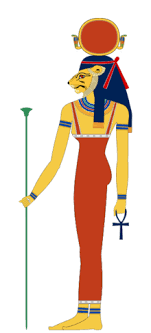
Tefnut was one of the first Egyptian gods created by the creator god Ra. She was created along with her brother Shu (Egyptian god of air).
Ancient Egyptians believed that Tefnut was the goddess of a number of things, including law, justice, fertility, water and rain. Her association with water and rain made her a very important Egyptian goddess. She was primarily venerated as the deity that made the land of Egypt fertile.
The union between Tefnut and her brother Shu produced two deities – Geb, the god of the Earth, and Nut, the goddess of the Sky. Tefnut’s name evokes the meaning of water when translated to English. She was also known by epithets such as “She of moisture” and “Lady of the Flame”.
In some cases, Tefnut was seen as the both the right and left eye of the Sun god Ra. Her role in the underworld when it came to weighing the hearts of the dead meant that she was associated with Ma’at, the Egyptian goddess of law and order.
Some of the commonest symbols of Tefnut are scepter (a symbol of power), the ankh (a symbol of life), and the Sun disc.
Read More:
NUT
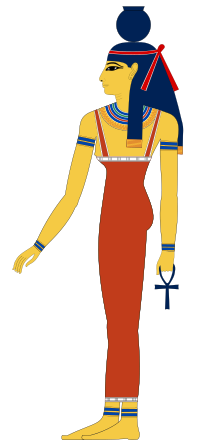
Considered as one of the most revered Egyptian goddesses, the goddess Nut was the daughter of Shu, the god of the air, and Tefnut, the goddess of moisture. She was known as the sky goddess who gave birth to the sun (i.e. the sun god Ra) on a daily basis. As a result of this, she held a very important place in the Egyptian pantheon of gods.
Nut was born alongside her brother/consort Geb, the god of the Earth and vegetation. Geb and Nut went on to bring forth four important deities called Osiris, Isis, Seth, and Nephthys.
The goddess Nut is famous for being one of the nine gods that make up the “Ennead” (the Ennead of Heliopolis). The nine gods – Atum, Shu, Tefnut, Geb, Nut, Osiris, Isis, Seth, and Nephthys – constituted an important group of gods in ancient Egypt. As a protector goddess, she was known as “She who Protects” or “She who holds a Thousand Souls”.
Nut is believed to have gone against her grandfather, Ra, in order to bring forth her children. The goddess solicited the help of Thoth, the god of wisdom and knowledge, in securing five extra days in order to bring forth her children. Angered by Nut’s defiance, Ra sent Shu (air) to permanently separate Nut (sky) from her husband Geb (earth).
Common depictions of Nut include ones where she is shown as a young woman with a pot on top of her head. In some cases, however, she is shown as a cow. The ancient Egyptians believed that by depicting her as a cow it would reinforce her traits as a deity that nourished the entire land. Other symbols of Nut include the sycamore tree and a ladder.
MAAT
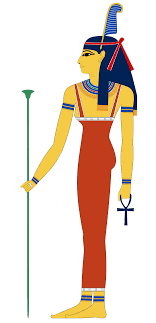
Egyptian goddesses |Ma’at
The ancient Egyptian goddess of truth and order, Ma’at (meaning ‘that which is straight’) was regarded as the divine being that kept the universe from falling into chaos.
To many ancient Egyptians, Ma’at emerged around the same time creation began. According to myth, Ma’at was the glue that kept things together, preventing cosmos from disintegrating. Thus her presence gave balance and meaning to the universe.
In some cases, instead of her being the divine force that came to being, she was seen as the daughter of Ra and Hathor.
Ma’at’s consort was Thoth, the goddess of wisdom, time and writing. Both Ma’at and Thoth played a tremendous role in judging the souls of the dead in the underworld. During judgment, the feather of Ma’at was weighed against the heart of the dead on a scale. Should the heart of the dead outweigh the feather, the dead was instantly gulped up, vanishing into nonexistence. However, was the heart of the dead found lighter than the feather, then the dead would be sent to spend eternal bliss in the afterlife.
And interestingly enough, Ma’at’s veneration by the ancient Egyptians was possibly influenced by the constant dread of falling into chaos and despair.
Did you know: According to the ancient Egyptians, the principles of Ma’at applied equally to everyone?
BASTET
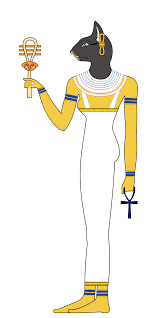
Bastet, also known as Bast or Ubaste, was a famous Egyptian deity whose area of control included fertility, protection, pregnancy, ointments and warfare. It was believed that Bastet was born to the Sun god Ra and the goddess Isis. Bastet and Ptah – the god of artisans and creation – gave birth to Maahes, the lion-headed god of war and weather.
Bastet is most known as cat goddess or a lioness goddess in general. The ancient Greeks called her “Ailuros”, which literally means “cat”. In some accounts however, Bastet was depicted as a lioness. This depiction of Bastet was seen in similar light as Sekhmet’s, the fierce Egyptian goddess of warfare and restoration.
In her milder form as cat, she was revered for the role she played as protector of the home. Bastet’s hieroglyphic symbol is an ointment jar. Often times, ancient Egyptians smeared ointments all over their body to act as a shield against evil spirits. She also served as Ra’s protector against the evil bite of the serpent Apophis (Apep).
In addition to cats, Bastet was generally associated with items suchs as the solar disk and an ointment jar.
Her place of worship was mainly at a temple in Bubastis, which means “the House of Bastet”. Epithets used to describe her include – “The Lady of Dread” and “The Lady of Slaughter”. Those two epithets emphasize her destructive side.
HATHOR
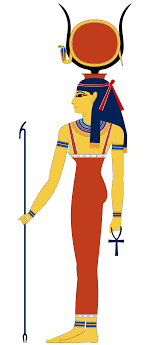
Most likely worshipped from the Predynastic Period (prior to 3100 BCE), Hathor was an important sky deity of women, fertility, love and joy. She was also closely associated with motherhood and wealth. This trait of hers was often symbolized by her title ‘Mother of Creation’ – and as such, Hathor was also portrayed as the wife of Ra and sometimes Horus the Elder.
Very interestingly, Hathor had many origin stories in ancient Egyptian religion. In older accounts, Hathor was revered as the cosmic mother of creation as well as the mother of the Egyptian pharaohs. This role of hers was symbolized by her title “The House of Horus”.
With regard to her physical attributes, Hathor was generally depicted as a young, beautiful woman with two cow horns on her head. In between those horns was often a sun disk attached to to her headdress.
Hathor’s association with cows reinforces the notion that she was the provider for all the inhabitants of the land of Egypt. She was a very powerful deity who had the ability to fully provide food, love and warmth to the entire population. Her motherly love also extended to the afterlife, where she comforted those that were troubled and forlorn.
Famous Hathor places of worship were at the Dendera Temple, which is about 38 miles away from Luxor.
MUT

One of the major ancient Egyptian goddess during the 18th dynasty (1530-1291 BCE), Mut – the wife of Amon, and the mother of Khonsu, was often perceived as the great divine mother of the gods. Believed to be the daughter/consort of the sun god Ra, Mut played an important role in the Egyptian pantheon, changing features over time.
According to some origin stories of Mut, the goddess emerged from the watery abyss of Nu and went on to create the entire universe, including the Egyptian gods and goddesses. Owing to this, Mut was sometimes described as “She Who Give Birth” or “Mother of the Gods”. Other accounts of the myths state that Mut emerged from the Nile River Delta.
Mut was believed to be a sky goddess, and hence the protector of the land of Egypt. She was commonly worshiped in Thebes. Along with her husband Amon and her son Khonsu, Mut made up the Thebian triad.
Popular depictions of Mut see her dressed elegantly, like the queen mother Egyptians believed she was. Atop her head was the double crown of Egypt – crowns of Upper and Lower Egypt. This symbolized her dominion over all of Egypt. Other common symbols of the goddess Mut include the uraeus (a rearing cobra) and the feather of Ma’at, She was also associated with animals such as cat, cow, lioness and vulture.
As one of the most worshipped Egyptian goddesses, Mut had some popular epithets such as: “Mistress of all the Gods”; “Lady of Heaven”; and “the Embodiment of Ka”. Her most famous temple was at Karnak, where she was worshiped alongside deities such as Amun and Khonsu.
Did you know: Mut’s name means “mother” in ancient Egypt?
SEKHMET
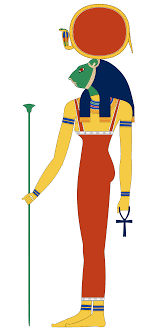
Playing a similar role as the one played by Bast (Bastet), Sekhmet was an Egyptian goddess both feared and revered. She was feared because her wrath knew no bounds. On the other hand, she was revered because she possessed copious amounts of healing abilities.
Sekhmet’s importance in ancient Egypt is evident in some of her epithets, including ones like “The One Before Whom Evil Trembles”. It was believed that Sekhmet brutally punished evil doers. In this role she was known as a protector goddess, offering protection in both this life and the afterlife. Her name itself translates to “power” or “might”.
Sekhmet was born to the Ra, the Egyptian creator/sun god. Sekhmet was known as the as sun deity and the embodiment of the Eye of Ra.
In her calmer self, Sekhmet was often associated with Hathor, the goddess of
She was also seen as the consort of Ptah, the god of creation and architects. In that role, she was seen as the mother of Nefertum, a divine flower that emerged during the creation of the universe.
Sekhmet’s major cult center was located at Memphis. Along with her son and husband, Sekhmet constituted an important deity in the city of Memphis.
SESHAT

Seshat – the daughter of Thoth and Ma’at – was one of the most famous Egyptian goddesses. Her association with Thoth made many Egyptians revere her as the goddess of wisdom, knowledge and writing. Often depicted as a young woman in a leopard skin, Seshat was described as the divine scribe and keeper of records.
She was famously known by her epithet “She who is the Scribe”. Similar to her father Thoth, Seshat was praised for her invention of writing, i.e. the Egyptian hieroglyph. Her sphere of influence also included astronomy, mathematics, and surveying. Another very common title of Seshat was “Mistress of the House of Books” – a reference to her being the patron goddess of library.
NEPHTHYS
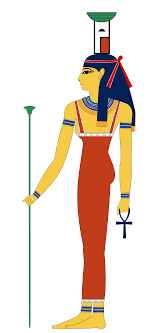
Nephthys, also known as Nebet-Het, was one of the children of the Earth god Geb and the sky goddess Nut. Thus her siblings were Osiris, Isis, Set and Horus the Elder. Picking up on her mother’s trait, Nephthys came to be seen as a sky goddess in charge of the family, hearth, protection, death, and the night. She was primarily worshiped in places such as Abydos, Senu, and Heliopolis.
Her origins go back to the Pre-dynastic Period, which stretched between 6000 BCE and 3150 BCE. The ancient Egyptians believed that Nephthys was the consort of Seth, the god of destruction and violence. In one account of the story, her union with Osiris brought forth Anubis, the god of funeral and embalming.
The meaning of name comes out as “Lady of the House”. This reinforces her role as the goddess of the hearth and family.
Nephthys’ worship reached its peak around the New Kingdom era (c. 1552 – c. 1070 B.C.E). The pharaohs of the 19th Dynasty were particularly fond of Nephthys. Many of those pharaohs venerated her as the divine mother and protector of the royal house.
As a sky goddess, Nephthys is sometimes depicted with outstretched wings. In some cases, she was depicted with a basket on top of her head. She was symbolized by a number of animals and items, including vulture, hawk, falcon, temple and kite.



























